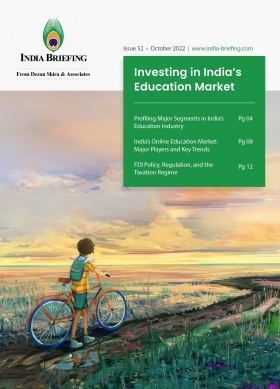Everything You Need to Know About Digital Banking Units in India
India recently announced the launch of 75 digital banking units across 75 districts in India, including at least one unit in each state and Union Territory (UT). These units intend to simplify user banking experience and further financial inclusion, and offer a cross-section of products and services such as the opening of savings accounts, balance-check, printing passbooks, transfer of funds, investment in fixed deposits, loan applications, etc.
India recently saw the launch of 75 digital banking units across 75 districts in the country, aimed at furthering financial inclusion and enhancing banking experience for users. These units will provide seamless and secure banking services with minimum infrastructure involving zero paperwork, making it a simplified and user-friendly process.
Here’s a brief explanation of everything you need to know about digital banking units in India.
What is digital banking?
The Reserve Bank of India (RBI) defines digital banking as present and future electronic banking services provided by a licensed bank for the execution of financial, banking and other transactions, instruments through electronic devices or equipment over websites (online banking), mobile phones (mobile banking) or other digital channels which involve significant level of process automation, and cross-institutional service capabilities running under enhanced technical architecture and differentiated business strategy.
What are digital banking units and how will they help users?
The digital banking units, set up in collaboration with nearly 24 public and private banks, are brick-and-mortar outlets that are equipped with tablets and internet services to provide individuals and small businesses with a variety of digital banking facilities, such as the opening of savings accounts, balance-check, printing passbooks, transfer of funds, investment in fixed deposits, loan applications, stop-payment instructions for checks issued, applications for credit and debit cards, and tax and bill payment and nominations.
Presently, there are 11 public sector banks, 12 private sector banks, and one small finance bank participating in the digital banking program.
According to the RBI, these digital banking units will “enable customers to have cost-effective access and enhanced digital experience of such products and services in an efficient, paperless, secured and connected environment with most services being available in self-service mode at any time, all year round.”
Who can open digital banking units in India?
Scheduled Commercial Banks – other than Regional Rural Banks (RRBs), Payments Banks (PBs), and Local Area Banks (LABs) – with past digital banking experience are permitted to open digital banking units in Tier 1 (cities with population more than 100,000) to Tier 6 (cities with population less than 5000) centers, unless otherwise specifically restricted, without having the need to take permission from the RBI in each case.
These units will be treated as banking outlets (BOs). For the purpose of compliance requirements for these outlets, their location will be determined depending on where their business is sourced from, irrespective of their physical location.
The establishment of the digital banking units will be part of the digital banking strategy of the concerned banks. Their operational governance and administrative structure must be aligned with that of the Digital Banking Segment of the bank. Also, each digital banking unit must be housed distinctly, with separate entry and exit provisions. They will be separate from existing BOs with formats and designs appropriate for digital banking users, equipped with devices such as interactive teller machines, teller and cash recyclers, interactive digital walls, video KYC apparatus, etc.
How will digital banking units function in India?
On October 17, 2022, 75 digital banking units became operational across 75 districts in India. As of now, there is at least one digital banking unit set up in each of the 29 states and eight union territories (UTs).
The states of Karnataka, Tamil Nadu, Uttar Pradesh, Odisha, and Rajasthan have four digital banking units each, followed by Gujarat, Kerala, Madhya Pradesh, Maharashtra, Punjab, Sikkim and Telangana, with three units each.
What transactions can be done at a digital banking unit?
Two private sector banks – ICICI Bank and HDFC – have announced they will set up digital banking units in India.
- ICICI bank units will have two distinct features – a self-service zone and a digital assistance zone. At the self-service zone, customers can access ATM, a Cash Deposit Machine (CDM), and a Multi-Functional Kiosk (MFK) that offers services like printing of passbook, depositing cheques, and accessing internet banking. It will also provide a digital interactive screen where customers can interact with a chatbot to know about products, offers, and mandatory notices. The digital assistance zone will have branch officials to assist customers to undertake the services, including opening of savings account, current account, fixed deposit, and recurring deposit etc.
- HDFC bank’s digital banking unit will have a self–service zone for customer transactions using Interactive ATMs, CDMs, interactive digital walls, net banking kiosks / video calls and tab banking. There will also be an assisted zone in a unit manned by two bank staff.
What are the products and services offered by digital banking units?
Each digital banking unit must offer certain minimum digital banking products and self-service fulfilment services. However, banks have the freedom to offer any other product or service in addition to the minimum bouquet to cater to the specific needs of the service area. Any product or service that can be provided digitally through internet banking or mobile banking can be provided in the digital banking unit.
Liability products and services
- Account opening: Saving bank account under various schemes, current account, fixed deposit, and recurring deposit account.
- Digital kit for customers: Mobile banking, internet banking, debit card, credit card, and mass transit system cards.
- Digital kit for merchants: UPI QR code, BHIM Aadhaar, POS, etc.
Asset products and services
- Making applications for and onboarding of customer for identified retail, MSME, or schematic loans. This may also include end-to-end digital processing of such loans, starting from online application to disbursal.
- Identified Government-sponsored schemes, which are covered under the national portal.
Digital services
- Cash withdrawal and cash deposit only through ATM and CDM respectively – no physical cash acceptance or disbursal across counters.
- Passbook printing / statement generation.
- Internet banking kiosk, which may also include facilities to provide all or majority of services available on internet banking including indent and issuance, processing of cheque book request, receipt and online processing of various standing instructions of clients.
- Transfer of funds (NEFT/IMPS support).
- Updation of KYC, other personal details, etc.
- Lodging of grievance digitally and acknowledgement thereof and also tracking of resolution status.
- Account opening kiosk.
- Kiosk with e-KYC/ video KYC.
- Digital onboarding of customers for various governmental schemes.
About Us
India Briefing is produced by Dezan Shira & Associates. The firm assists foreign investors throughout Asia from offices across the world, including in Delhi and Mumbai. Readers may write to india@dezshira.com for more support on doing business in in India.
We also maintain offices or have alliance partners assisting foreign investors in Indonesia, Singapore, Vietnam, Philippines, Malaysia, Thailand, Italy, Germany, and the United States, in addition to practices in Bangladesh and Russia.
- Previous Article How High-Tech Innovation is Advancing India’s Healthcare Capabilities
- Next Article India’s Tier 2 and Tier 3 Cities: Are They Right for Your Business?








